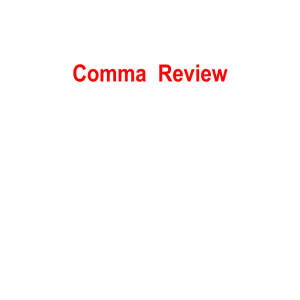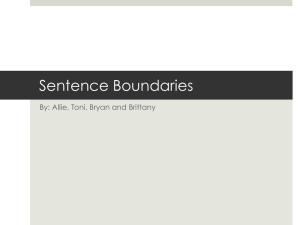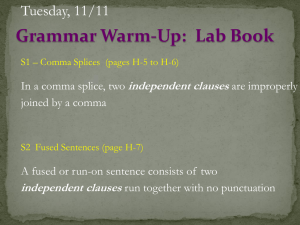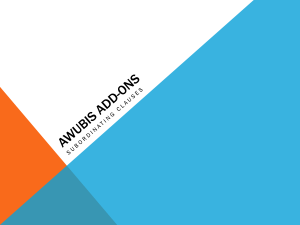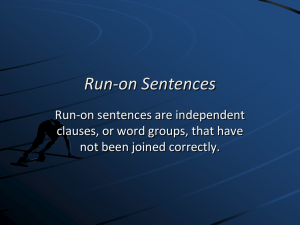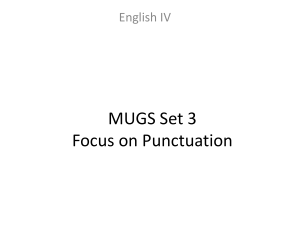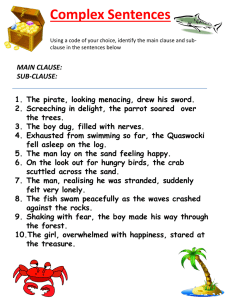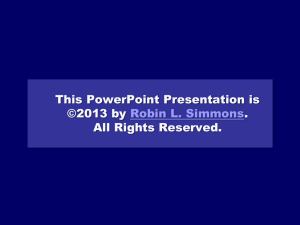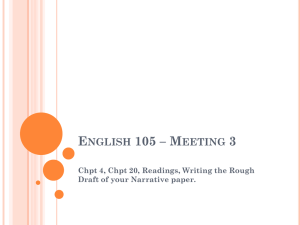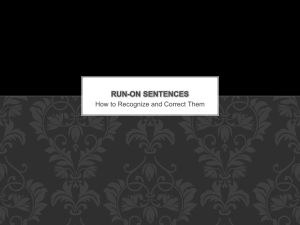Improving Grammar and Mechanics PowerPoint
advertisement
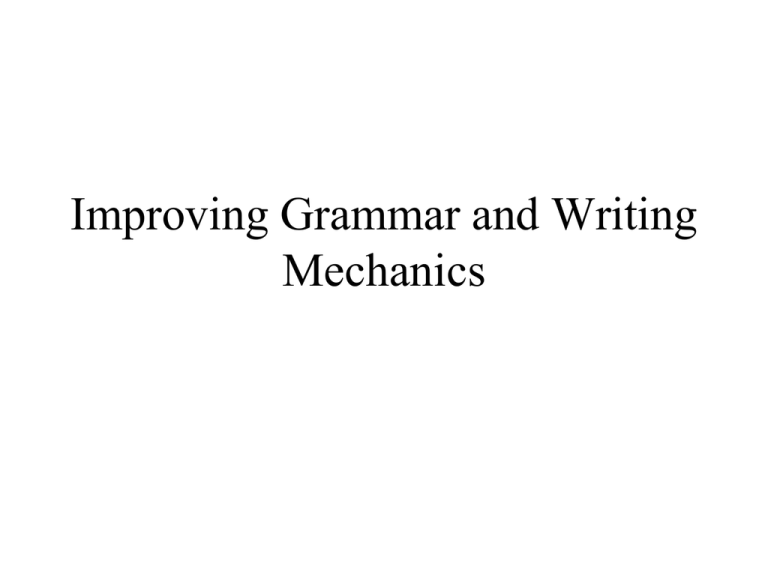
Improving Grammar and Writing Mechanics Punctuation Identifying your punctuation marks: . Period , Comma : Colon ; Semicolon ‘ Apostrophe “” Quotation marks The Comma When do you use a comma? There are six major uses of a comma: #1.) Use a comma before a coordinating conjunction joining an independent clause. #2.) Use a comma after an introductory clause. #3.) Use a comma between all items in a series of three or more. #4.) Use a comma between coordinate adjectives not joined by “and” #5.) Use a comma to set off nonrestrictive elements Do not use a comma to set off restrictive elements. #6.) Use a comma to set off transitional and parenthetical expressions, absolute phrases, or phrases expressing contrast. Rule #1.) Use a comma before a coordinating conjunction connecting two independent clauses. Review: What’s an independent clause? An independent clause includes both a subject and a predicate, and it can stand alone. Ex. “Bill ran.” (Subj)(predicate)=Independent clause “Tim was reading his favorite novel.” (Subj)(predicate)=Independent clause. Rule #1.) Use a comma before a coordinating conjunction connecting two independent clauses. (cont.) What are your seven coordinating conjunction? F.A.N.B.O.Y.S. For And Nor But Or Yet So Rule #1.) Use a comma before a coordinating conjunction connecting two independent clauses. (cont.) “Mary liked Scarface but Jo hated it.” (I.C.) (C.C.) (I.C.)=missing comma “Mary liked Scarface, but Jo hated it.”=Correct! “My girlfriend locked me out so I called a cab.” (I.C.) (C.C.) (I.C.)=missing comma “My girlfriend locked me out, so I called a cab.”= Correct! Rule #2.) Use a comma after an introductory clause. What is an introductory clause? A phrase that functions like an adverb. Introductory clauses usually tell: when, where, why, how, under what conditions, the main action of the sentence occurred. Rule #2.) Use a comma after an introductory clause. (Cont.) “When it started raining I went inside.” (introductory clause) (main clause) =missing a comma , “When it started raining I went inside.”= Correct! “Since she hates technology Julia never bought a computer.” (introductory clause) (main clause) =missing a comma , “Since she hates technology Julia never bought a computer.”=Correct! “When the racecar crashed the gas tank exploded.” (introductory clause) (main clause) =missing a comma , “When the racecar crashed the gas tank exploded.”=Correct! Rule #3.) Use a comma in between all items in a series of three or more. “Nick Matt and Tina joined the circus.” There are THREE names in this list, so they should be separated by commas. , , “Nick Matt and Tina joined the circus.” =Correct! “Method Man and Ghost Face Killa are both in the Wu Tang Clan.” There are only TWO items in this list, so they do not need to be separated by a comma. =Correct as is! “Early to bed and early to rise, makes a man healthy wealthy and wise.” There are three adjectives in this list, so they should be separated by commas. , , “Early to bed and early to rise, makes a man healthy wealthy and wise.” =Correct! Rule #4.) Use a comma between coordinate adjectives; do not use a comma between cumulative adjectives. What the heck is a coordinate adjective?! Coordinate adjectives each modify a noun separately. They CAN be separated by the word “and.” Well, then what’s a cumulative adjective?! Cumulative adjectives modify a noun cumulatively. They CANNOT be separated by the word “and.” Rule #4.) Use a comma between coordinate adjectives; do not use a comma between cumulative adjectives. (Cont.) The “and test”: Coordinate adjectives: “Sandra is a quiet, patient, attentive student.” “quiet,” “patient,” and “attentive” CAN be separated by the word “and.” Therefore, we should put commas in between them. Cumulative adjectives: “The evil witch lived in the spooky old gray house.” “spooky,” “old,” and “gray” CANNOT be separated by the word “and.” Therefore, we do not need commas in between them. Rule #4.) Use a comma between coordinate adjectives; do not use a comma between cumulative adjectives. (Cont.) Do the following examples need any commas? “This is the second ugly blue rancher we’ve looked at today!” “Second,” “ugly,” and “blue” are cumulative adjectives. Correct as is! “John is a grumpy lazy nasty old man.” “Grumpy,” “ugly,” and “lazy” are coordinate adjectives. , , “John is a grumpy lazy nasty old man.” =Correct! #5.) Use commas to set off nonrestrictive elements. Do not use commas to set of restrictive elements. What the heck is a restrictive element?! A restrictive element is a part of a sentence that limits or restricts the meaning of the word it modifies. It adds an irremovable layer of meaning to a word. Ex. “I want a car that won’t break down.” “The kids need shoes that don’t have holes in them.” If you remove the phrases “that won’t break down” and “that don’t have holes in them” then these two sentences mean completely different things. Ok, but then what’s a nonrestrictive element? A nonrestrictive element modifies a part of a sentence without severely limiting it. A nonrestrictive element adds additional information to a sentence. Ex. “Sandy read Infinite Jest, which is a really big book.” “Sam’s bike, which is a blue Schwinn, is really cool.” #5.) Use commas to set off nonrestrictive elements. Do not use commas to set of restrictive elements. Do the following examples need commas? “The jeans that I stuck in the wash really stunk” =Correct as is! “Evan’s work which is on the corner of 13th and Walnut has great coffee.” The nonrestrictive element needs to be set off with commas. , , “Evan’s work which is on the corner of 13th and Walnut has great coffee.”=Correct! “The coffee shop that’s at the corner of 13th and Walnut has great coffee.” =Correct as is! “Parker’s favorite restaurant that serves fish just closed down.” =Correct as is! #.6) Use a comma to set off transitional and parenthetical expressions , absolute phrases, and elements expressing contrast. What’s a transitional expression? However, therefore, moreover, thus, as a matter of fact, what’s more, anyway, after all, subsequently, similarly, besides, for example… , Ex. “Mary failed her quiz. However she learned a lot of fun stuff about grammar.” , “Sylvia can’t sing. In fact she’s tone deaf.” #.6) Use a comma to set off transitional and parenthetical expressions , absolute phrases, and elements expressing contrast. (Cont.) What’s a parenthetical expression? A phrase that is set apart from the rest of a sentence. Parenthetical expressions generally interrupt the flow of a sentence. Ex. “Cancer, as far as we know, is not curable.” “O.J. Simpson, according to Judge Lance Ito, is not guilt of murder.” #.6) Use a comma to set off transitional and parenthetical expressions , absolute phrases, and elements expressing contrast. (Cont.) What’s an absolute phrase? A phrase that modifies a whole sentence. Absolute phrases usually occur at the beginning or end of a sentence. Ex. “Larry is six feet tall, give or take a few centimeters.” “John finally decided to call a tow truck, having been broken down for three hours.” The Comma (Review) Identify any commas that are either missing or unnecessary in the following examples. #1.) “Bill ran and Mary swam.” , “Bill ran and Mary swam.” #2.) “I went to Checkers and bought a burger” Correct as is! #3.) “My girlfriend locked me out so I called a cab.” , “My girlfriend locked me out so I called a cab.” #4.) “Since she hates technology, Julia never bought a computer.” Correct as is! The Comma (Review) Identify any commas that are either missing or unnecessary in the following examples. #5.) “We were quickly seated, and served.” “We were quickly seated and served.”=No comma necessary. Compound predicate. #6.) “Johnny crashed his fifth, used car.” “Johnny crashed his fifth used car.”=No comma necessary. Cumulative adjectives. #7.) “Mary failed her quiz. However she learned a lot about grammar.” , “Mary failed her quiz. However she learned a lot about grammar” #8.) “I want a car that won’t break.” = Correct as is! Comma abuse! Common comma-related mistakes: #1. Do not use a comma between compound elements that are not independent clauses. Ex. “Julia got in her car, and drove away.” (subj.) +(compound predicate)=no comma necessary! “Julia got in her car and drove away.” =Correct! “Benny picked up his keys, and left the house.” (subj.) +(compound predicate)=no comma necessary! “Benny picked up his keys and left the house.” =Correct! Comma abuse! #2.) Do not use a comma after a coordinating conjunction. Ex. “Bill went jogging, but, Sally watched TV.” “but” is a coordinating conjunctions, so no comma is necessary. “Bill went jogging, but Sally watched TV.”=Correct! “I couldn’t find my plane ticket, so, they wouldn’t let me fly.” “so” is a coordinating conjunctions, so no comma is necessary. “I couldn’t find my plane ticket, so they wouldn’t let me fly.” Comma abuse! #3.) Do not use a comma to connect two independent clauses without also using a coordinating conjunction. This is called a comma splice. Ex. “T.S. Eliot isn’t my favorite poet, I prefer Wallace Stevens.” “T.S. Eliot isn’t my favorite poet. I prefer Wallace Stevens.”=Correct! “Video games are often violent, however, they can also be a great teaching tool.” “Video games are often violent; however, they can also be a great teaching tool.” The colon and the semicolon When do you use a semicolon? Use a semicolon between two closely linked independent clauses. Ex. “The Godfather was good; the sequel was great.” “Screwdrivers are useful; however, electric screwdrivers are very useful.” “Filling my car with gas costs a lot of money; riding my bike does not.” The colon and the semicolon (cont.) When do you use a colon? Use a colon after an independent clause to direct attention to a list, an appositive, or a quotation. Ex. “Cat went to the grocery store and bought the essentials: bread, peanut butter, and coffee.” “Remember the words of John F. Kennedy: ‘Ask not what your country can do for you; ask what you can do for your country.’” “My bike needs a few new parts: brakes and tires.” The colon and the semicolon review Do the following examples need colons or semicolons? #1.) “Our house is blue, the neighbor’s house is yellow.” “Our house is blue; the neighbor’s house is yellow.” =Correct! #2.) “Wilson had many criminal offenses. assault, robbery, and murder.” “Wilson had many criminal offenses: assault, robbery, and murder.” =Correct! #3.) “Taylor’s suit was nice; however, it was very expensive.” =Correct as is! The colon and the semicolon review (cont.) Do the following examples need colons or semicolons #4.) “Pat’s car is all paid off unfortunately is also won’t start.” “Pat’s car is all paid off; unfortunately is also won’t start.” =Correct! #5.) “Martin Luther King began his famous speech with the following words, ‘I have a dream.’” “Martin Luther King began his famous speech with the following words: ‘I have a dream.’” =Correct! The apostrophe When do you use an apostrophe? There are two major uses of an apotrophe: #1.) to indicate that a noun is possessive ’ Ex. “Sam s bike is cool.” “Someone’s cell phone is ringing.” “Martha’s art project was really neat.” The Apostrophe (Cont.) #2.) Use an apostrophe to mark omission is contractions. Ex. “We’ll never make it out alive.” “She’s the smartest person that I know.” “Stewart wasn’t feeling well today.” The Apostrophe (Cont.) Again, an apostrophe indicates a possessive noun; however, there are several stipulations to that rule: #1.) If the noun does not end in “S,” simply add an apostrophe and an “S.” Ex. “The lawyer’s desk.” “John’s drum set.” #2.) If the noun is singular and ends in an “S,” you still add an apostrophe and an “S.” Ex. “Venus’s atmosphere.” “Julius’s television.” “Jesus’s cross.” The Apostrophe (Cont.) #.3) If the noun is plural and ends in “S,” add only the apostrophe. Ex. “Both fans’ motors are broken. “Neither of the cars’ heaters worked.” “The two diplomats’ computers were stolen.” #4.) To show joint possession, simply use an apostrophe and an “S.” Ex. “Bill and Ted’s Excellent Adventure.” “The husband and wife’s wedding vows were renewed.” #5.) To show individual possession, make all nouns possessive. Ex. “Hegel’s and Marx’s philosophies are drastically different.” “Cat’s and Matt’s jobs are not even remotely similar.” The Apostrophe Review Do the following examples need apostrophes? #1.) “The students desk is messy.” “The student’s desk is messy.” =Correct! #2.) “Both students desks are messy.” “Both students’ desks are messy.” =Correct! #3.) “I cant do my work!” ’ “I can t do my work!” =Correct! The Apostrophe Review (cont.) Do the following examples need apostrophes? #4.) “I prefer Henry James later novels.” “I prefer Henry James’s later novels.” =Correct! #5.) “You can’t do that on television.” = Correct as is! #6.) “Mike and Bills apartment is expensive.” “Mike and Bill’s apartment is expensive.”=Correct! Run-on sentences There are two types of run-on sentences #1.) Fused sentences- when a writer joins independent clauses without any punctuation or conjunctions. “Air pollution poses risks to all human beings it can be deadly for asthmatics.” (independent clause #1) (independent clause #2) “Air pollution poses risks to all human beings. It can be deadly for asthmatics.” =Correct! Run-on sentences (Cont.) #2.) Comma splice- when a writer joins independent clauses with a comma but doesn’t use a coordinating conjunction. “Violent films can have an impact on the viewer, they specifically affect kids.” (independent clause #1) (independent clause #2) “ Violent films can have an impact on the viewer, kids.” =Correct! but they specifically affect Run-on sentences (Cont.) A more common variety of the comma splice occurs when a writer connects two independent clauses with a comma and a word that is not a coordinating conjunction. REMEMBER: the seven coordinating conjunctions in English are: and, but, or, nor, for, so, yet. Ex. “Yianni was great cook, however, he never cleaned up after himself.” (independent clause #1) (independent clause #2) “Yianni was great cook; however, he never cleaned up after himself.” =Correct! Run-on sentences (cont.) Identify and correct the run-on sentences in the following examples: #1.) “Depression is a disease, it is caused by a chemical imbalance.” . “Depression is a disease It is caused by a chemical imbalance.” =Correct! #2.) “Babies respond to music studies suggest that they are soothed by classical music specifically.” “Babies respond to music. Studies suggest that they are soothed by classical music specifically.” =Correct! Run-on sentences (cont.) Identify and correct the run-on sentences in the following examples: #3.) “Cigarette smoking is bad for your health, moreover, it is unattractive.” “Cigarette smoking is bad for your health; moreover, it is unattractive.” =Correct! #4.) “Sleep debt is the result of repeatedly getting inadequate amounts of sleep it is a common problem for college students.” “Sleep debt is the result of repeatedly getting inadequate amounts of sleep. It is a common problem for college students.” =Correct! Proper MLA Citation Whenever you borrow someone else’s ideas or use a quotation, it is very important to properly cite those ideas; otherwise, you might be guilty of plagiarism. To properly cite something in MLA format, you must provide two separate citations for all of the borrowed material: one in parenthesis directly following the quotation, and one on a separate page titled “Works Cited.” Proper MLA Citation (cont.) Parenthetical citations: #1.) As the narrator of On the Road reminds the reader, “I first met Dean not long after my wife and I split up” (Kerouac 1). #2.) Ehrenreich discusses the issue of sweatshops, pointing out that “[i]n 1996, the National Labor Committee Education Fund in Support of Worker and Human Rights in Central America revealed that some Kathie Lee clothes were being sewn by children as young as twelve” (Ehrehreich 185). #3.) When the novel begins, McTeague takes “his dinner at two in the afternoon at the car conductors’ coffee joint on Polk Street” (Norris 5). Proper MLA Citation (cont.) This declaration of the success of the Darwinian/Spencerian paradigm is by no means celebration; rather, the novel is equal in its in prosecution of both classes. Tichi argues: Perceptive as he is, then, Ralph is shown to represent a lapsed, superannuated transcendentalism which is superficial, flaccid, feminized, effete. We see, in sum, Wharton’s deliberate misreading of Emerson for fictional objectives that prove to serve a Darwinian scheme. Ralph’s self-sacrifice for Undine is nothing more than selfdefeat. (Tichi 103) If you are quoting four or more lines of text, then you must put it in block format. Proper MLA Citation (cont.) Works Cited Showalter, Elaine. “Spragg: The Art of the Deal.” The Cambridge Companion to Edith Wharton. Ed. Millicent Bell. New York: Cambridge University Press, 1995. 87-97. Tichi, Cecilia. “Emerson, Darwin, and The Custom of the Country.” A Historical Guide to Edith Wharton. Ed. Carol J. Singley. New York: Oxford University Press, 2003. 89-114. Wharton, Edith. The Custom of The Country. New York: Macmillan, 1987. Proper MLA Citation (cont.) Do any corrections need to be made to the following parenthetical citations? #1.) At the beginning of the story, “Lily, the caretaker’s daughter, was literally run off her feet.” (Joyce page186). At the beginning of the story, “Lily, the caretaker’s daughter, was literally run off her feet” (Joyce 186). =Correct! #2.) Lynch argues, “that’s like putting a band-aid on a shotgun wound” (Lynch,94). Lynch argues, “that’s like putting a band-aid on a shotgun wound” (Lynch 94). =Correct! Proper MLA Citation (cont.) Do any corrections need to be made to the following parenthetical citations? #3.) Henri claims, “I didn’t finish the milk! It was my cat who did it.” (Shloshy page #498). Henri claims, “I didn’t finish the milk! It was my cat who did it” (Shloshy 498). =Correct! #4.) According to O’Neill, “The Intergovernmental Panel on Climate Change, the earth’s average temperature will increase ten degrees within the next five years” (O’Neill 847). =Correct as is!
